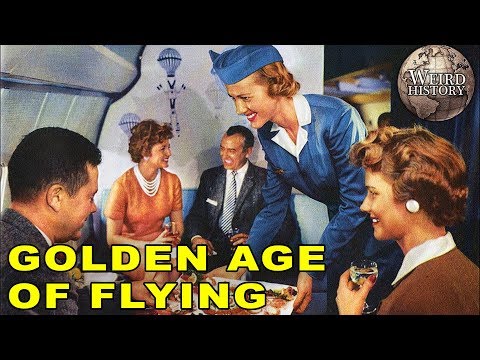Your Ticket Cost A Lot
When booking a flight today, travelers posses plenty of options when trying to find the best price for a trip. During the Golden Age, choices were more limited - and way more expensive. According to a TWA brochure from 1955, a round-trip ticket from Chicago to Phoenix cost $138, which seems like a good deal. When you account for inflation, though, the not-even-cross-country trip cost about $1,200 in today's money.
According to aviation history expert Guillaume de Syon, "[Depending] on the route, it was four to five times as expensive to fly in the Golden Age." International travel, meanwhile, was so cost prohibitive, only the wealthiest could afford it.
You'd Need To Dress Up If You Wanted To Fit In
Since flights were a luxurious experience, passengers generally dressed in appropriate attire - three-piece suits and hats for men, and dresses, high heels, and fine jewelry for women. Passengers saved up to fly, and it was a big event - so wanting to look your best made perfect sense.
During the 1960s, it became more acceptable for men to dress down a bit with a flowered tie or turtleneck shirt. Women could don scarves and even fashionable beads. It wasn't until the 1980s, though, that clothes stopped making the passenger, and travelers began dressing for comfort when flying.
You Didn't Have To Go Through Security

- Photo:
Without security checkpoints slowing things down, getting through the airport was a breeze. You didn't need your ID, and you could show up at the airport 20 or 30 minutes before your flight and basically walk right onto the plane. So, family and friends could walk you directly to the gate. Sounds nice, right?
Maybe not. Any time saved avoiding security may have been undone by someone commandeering the plane and diverting it to Cuba or another unintended destination. The lack of oversight on the ground led to a "Golden Age of hijacking," as well. In the 1960s, there were dozens of plane hijackings every year, making air travel decidedly less safe.
You Had Plenty Of Room At Your Seat
On flights in the early 1950s, travelers didn't need to decide between business or economy class seats, because there wasn't a distinction between them. Those early flights were luxurious from the front to the back of the cabin. Even after airlines started adding first-class sections, everyday passengers still had significantly more legroom than on a modern aircraft. First-class passengers received something resembling a hotel room, complete with beds, while economy class seating was more akin to business class on current flights.
Your Flight Attendant Had To Meet A Lot Of Intrusive Requirements
- Photo:
Just like the passengers, the flight attendants also dressed to impress. During the early 1950s, air hostesses, as they were often known, wore high heels until after take-off, white gloves, and even a corset under their tightly fitting suit.
Airlines also maintained specific requirements regarding the appearance and behavior of flight attendants. Training manuals specified how long hair could be and how much a person could weigh. The women were also supposed to be single and talkative, yet maintain "high moral standards" while employed by the airline. By the 1960s, the skirts that were worn by 'stewardesses' - as they were then known - grew increasingly shorter, appealing to the mostly male clientele.
Your Flight Would Be Noisy And Turbulent
- Photo:
Until the late 1950s, passenger planes with propellers like the Lockheed Constellation and Douglas DC-7 created a ton of noise. Often, if a flight didn't go above 10,000 to 12,000 feet, the plane remained unpressurized. Flights were bumpy; planes couldn't avoid bad weather; and, when engines got bigger, turbulence was more challenging to manage. Passengers definitely needed those airsick bags.
Whatever discomfort passengers felt was also multiplied, since trips frequently consisted of more than one flight. It could take four or five planes to get from one side of the US to the other, not to mention the number of connections a person needed for international travel. And with only a few airlines serving different regions, this meant a mix of airlines, too.
COLLECTION20 LISTS
Fly the Friendly SkiesLists about airplanes, the best and worst parts of flying, and how to spend hours trapped in an aluminum tube.





